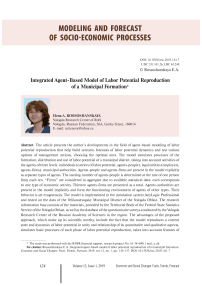Integrated agent-based model of labor potential reproduction of a municipal formation
Автор: Rossoshanskaya Elena A.
Журнал: Economic and Social Changes: Facts, Trends, Forecast @volnc-esc-en
Рубрика: Modeling and forecast of socio-economic processes
Статья в выпуске: 1 (61) т.12, 2019 года.
Бесплатный доступ
The article presents the author’s developments in the field of agent-based modeling of labor potential reproduction that help build scenario forecasts of labor potential dynamics and test various options of management actions, choosing the optimal ones. The model simulates processes of the formation, distribution and use of labor potential of a municipal district, taking into account activities of the agents of three levels: individuals (carriers of labor potential, agents-people), legal entities (employers, agents-firms), municipal authorities. Agents-people and agents-firms are present in the model explicitly as separate types of agents. The starting number of agents-people is determined at the rate of one person from each ten. “Firms” are considered in aggregate due to available statistical data: each corresponds to one type of economic activity. Thirteen agents-firms are presented as a total. Agents-authorities are present in the model implicitly and form the functioning environment of agents of other types...
Agent-based model, labor potential, labor potential reproduction, quality of population, municipal level
Короткий адрес: https://sciup.org/147224125
IDR: 147224125 | УДК: 331.101.26 | DOI: 10.15838/esc.2019.1.61.7
Текст научной статьи Integrated agent-based model of labor potential reproduction of a municipal formation
Reproduction of labor potential is one of the most problematic processes of the municipal level in recent decades. For example, in the Vologda Oblast since 2000 the working-age population has decreased by at least a quarter in more than half of the municipal districts. The structure of labor potential and trends of its formation, distribution and use are extremely unfavorable. Full restoration of the functioning labor potential is not observed either in quantitative or qualitative terms, thus we can only speak about contracted reproduction [1].
The sources and root causes of these problems lie both at macro and micro levels. Therefore, to break negative trends gradually is possible only by creating appropriate macroeconomic conditions and a favorable environment for labor potential functioning and effectively managing micro-level reproductive processes with regard to qualitative characteristics and behavior of the carriers of labor potential, i.e. individuals living in the territory of a municipality.
The management of labor potential reproduction is a complex and responsible task that demands consideration of a current state of the problem and puts forward increased requirements not only to decision makers’ skills, but also to the tools used for these purposes. At the moment, agent-based models, which have already received great recognition abroad [2; 3] and are gradually gaining popularity in Russia, are one of the most promising and flexible tools that can help develop adequate management decisions at various levels [4; 5].
As shown by our analysis [6], today all the necessary prerequisites to systematically implement agent-based models in the real practice of municipal government have been created in Russia: 1) the necessary stages of economic thought and information technology development are undergone; 2) the human factor role in socio-economic development is widely recognized; 3) the government and society show great interest in the issue of state and municipal management efficiency; 4) the regulatory and legal framework for strategic planning at management levels is formed. All this inevitably leads to the gradual informatization of management decisionmaking and the search for appropriate tools, such as agent-based models, giving an opportunity to simulate the control object most close to reality.
This class of models, based on the behavior of many heterogeneous agents, can become the most useful tool for decision makers, since it deals with problematic processes on the same level as managers [7, p. 121]. At the same time, in the society, artificially simulated “from bottom-up”, [8; 9] emergence phenomena and the self-organization processes can be observed, [10] though they are not initially programmed by a modeler. But the main thing is that by experimenting on an artificial society, the authorities are able to test management decisions and select the optimal ones that give the best result in the implementation [5], get the experience, information and knowledge about a management object, which is impossible and unethical to acquire through direct experiment on a real society.
Thus, the need for an adequate, modern and effective tool to test management decisions, as well as the severe situation in the field of labor potential reproduction outside large cities and the significant role of individual characteristics and behavior of individual agents in the reproductive process predetermine the relevance of agent-based modeling of labor potential reproduction at the municipal level.
The analysis of the Russian and foreign experience to work out agent-based models, dealing with different aspects of labor potential reproduction, shows the following: first, the integrated approach to the definition of labor potential of a territory, taking into account the essence and depth of this concept, is practically not used in the models built at the moment, except for E.D. Sushko’s works [11]; second, most models simulate certain aspects of reproduction, such as natural movement, labor market dynamics or labor behavior, and do not consider the entire reproductive cycle; and third, the model simplification of the real system does not always comply with the logic of the main phase processes, for example, if the unemployed are excluded from the model [12], the reproduction of the labor potential use phase is distorted [13].
In addition, the qualitative characteristics of workers are considered mainly within the framework of the human capital theory [14] and reduced to general and special skills [15]; it significantly reduces the possibility of analyzing the problems to reproduce a qualitative component of labor potential. Labor potential quality is a broader concept reflecting the whole complex of person’s various features and abilities that are required in labor activity. For example, moral and cultural levels or achievement need are not skills. Nevertheless, according to the results of the sociological monitoring of the qualitative state of labor potential of the Vologda Oblast population, conducted by the Vologda Research Center of the RAS in the region, more than a third of the working age employees consistently note the importance of the presence of developed moral qualities and high general culture for the successful implementation of labor activity. Less than 10% of the employees consider these qualities not important at all. This fact suggests the need to take better account of qualitative characteristics of the population in modeling labor potential reproduction.
The present study is aimed at elaborating a comprehensive agent-based model to reproduce labor potential of a municipal district, simulating the processes of formation, distribution and use of labor potential, taking into account the actions of agents of three levels: 1) individuals (carriers of labor potential), 2) legal entities (employers), 3) municipal authorities. To achieve the goal, the following tasks are solved: the conceptual model of labor potential reproduction at the municipal level is developed; the conceptual model is implemented in the form of an agent-based model; the model is tested on one of the Vologda Oblast districts; the model is calibrated and the series of computational experiments to simulate the dynamics of labor potential reproduction at different values of the controlled parameters of the model is carried out.
The advantages of the proposed approach, which make up its scientific novelty, include the fact that the model reproduces a current state and dynamics of labor potential in unity and relationship of its quantitative and qualitative aspects, simulates basic processes of each phase of labor potential reproduction, takes into account features of municipal statistics and authorities’ real powers. In addition, to describe people-agents’ labor potential quality, agentbased modeling uses a concept of qualitative characteristics of the population for the first time and each agent is endowed with eight basic qualities: physical and mental health, cognitive and creative potential, sociability, cultural and moral levels, achievement need. The agents of the same sex and age are not the same in the model.
Methodology
Let us consider the theoretical and methodological and information base of the study, as well as the specific methodology of the model.
Along with the above-mentioned concept of qualitative characteristics of the population, developed by the ISESP RAS and used by us to determine structural components of labor potential quality, the theoretical basis of the study includes:
-
1. the theory of labor potential and its reproduction, developed by A.S. Pankratov [17];
-
2. the integrated approach to understanding the essence of the socio-economic category “labor potential of a territory”, presented in the works of I.S. Maslova. It allows us to consider labor potential as a “generalizing characteristic of the measure and quality of a set of abilities to work” [18, p. 14]. In quantitative terms it is estimated according to a number of the working age population, and in qualitative terms – according t o a level of development of qualitative characteristics of the working age population;
-
3. the agent-based paradigm of simulation modeling [19].
The main research methods are the following: at the stage of information collection
– sociological and statistical methods (questionnaire and database statistical processing); at the stage of conceptual model development – abstraction and generalization; at the stage of computer model construction – agentbased modeling; at the stage of model testing – retrospective forecast and computational experiments; at the stage of work with scientific literature and results interpretation – general scientific methods of work with information (analysis, synthesis, etc.).
The information base of the research consists of Russian and foreign publications on agent-based modeling of socio-economic systems and various aspects of labor potential reproduction, statistical data of the Vologda Oblast Territorial Body of the Federal State Statistics Service (Vologdastat), presented in the annual statistical collections “Labor and employment in the Vologda Oblast”, “Age and gender composition of the Vologda Oblast population”, “Municipal districts and urban districts of the Vologda Oblast”, “Demographic yearbook of the Vologda Oblast”, etc., as well as the results of sociological measurements carried out by the Vologda Research Center of the Russian Academy of Sciences in the region, in particular, the data of the regular sociological monitoring1 of the qualitative state of labor potential in the Vologda Oblast [20], which helps fill the model with reliable and detailed information about quality characteristics of the working age population.


Figure 1. Structure of labor potential quality of an agent-person
Quality of labor potential of an agent-person

The use of the concept of population’s qualitative characteristics to describe labor potential of agents-people is a fundamental difference of our approach and allows us to provide a comprehensive quantitative and qualitative reflection of labor potential of a territory in the agent-based model. Based on the results of the monitoring of empirical data, each agent-person in the model is endowed with eight individual qualities: physical and mental health, cognitive and creative potential, sociability, cultural and moral levels and achievement need (Figure 1).
The method of measuring these qualities is based on the use of Likert scales2 that allow us to identify a degree of respondent’s consent with the questionnaire statements grouped into blocks. Each labor potential quality corresponds to a separate set of questions. As a result of quality measurements, a numerical estimate is obtained in the index form. In fact, the index is a ratio of the actual number of points on a particular scale to the maximum possible and is interpreted as follows: the closer the index value to a 1, the better developed the corresponding quality, and vice versa.
The physical health index is assessed on the basis of data on the frequency and severity of diseases, supplemented by self-assessment of health. The mental health index is measured by the presence of signs of mental instability. Cognitive potential is calculated on the basis of information about knowledge sources and respondent’s attitude to knowledge and education. Creative potential is evaluated on the basis of data on creative activities and attitude to creativity. The communicability index is calculated on the basis of information about the ability to communicate and interact. The cultural level is assessed by external and internal culture of a person. The moral level index is calculated on the basis of data on moral feeling and moral behavior. The level of achievement need development is determined on the basis of information about plans and intentions of a respondent [20]. The measurement method was first tested in 1996 and is still successfully used by the Vologda Research Center of the RAS to monitor the quality of labor potential of the region. In fact, it is the availability of unique data on the quality of labor potential and the behavior of the working age population together with the problem processes growing in the municipalities that prompted us to create an agent-based model for labor potential reproduction at the municipal level. Besides, we should emphasize that the used sociological method is not limited to the measurement of eight basic qualities. With the help of special formulas [16, 20] we can get aggregated properties of upper levels of the hierarchy and finally calculate a social capacity index – an integral indicator of labor potential quality, the values of which in the territorial context can be found in the article [1]. However, while constructing the model, we deliberately do not use aggregated indicators and consider only the qualities to be directly measured. We want to reflect a labor market more adequately, as in reality an employer puts forward requirements not to labor potential as a whole, but to the level of development of employee’s individual qualities.
It is important to note that to test the model, we conducted an in-depth study of labor potential quality in the pilot district, the Velikoustyugsky Municipal District, widely known as the “Father Frost’s Homeland” in 2017. This year, 400 people of working age have been interviewed in the district. In addition, in 2018 we organized an official working meeting with representatives of the Velikoustyugsky
Municipal District administration to discuss our developments and take into account real needs of the practice.
The basic concept of our agent-based model is as follows. It is believed that the reproduction of labor potential of a municipal formation is determined by the activities of agents of three types: individuals (carriers of labor potential, agents-people), legal entities (employers, agents-firms), municipal authorities. Such a composition of agents is justified not only by the compliance with the real system, but also by the study purpose. Agents-people and agents-firms are present in the model explicitly as separate types of agents. The starting number of agents-people is determined at the rate of one person from each ten. Such a good scale of the model can be achieved due to the small population of the municipality. It is usually necessary to use a larger scale in regional and country-level models: for example, in the agent-based regional model “Governor” the number of agents-people was determined
Table 1. Characteristics of model agents and their behavior
|
Agent type |
Number |
Key characteristics |
Available actions (behavior) |
|
Physical persons – labor potential carriers (“people”) |
5,783 agents at the start (one out of every ten at the beginning of 2011)) |
Gender, age, education, marital status, physical health, mental health, cognitive potential, creative potential, sociability, cultural level, moral level, achievement need, reproductive attitudes, etc. |
Get a job, resign, migrate, start a family, have a baby |
|
Legal entities-employers (“firms”) |
13 agents (each “firm” corresponds to 1 type of economic activity) |
Total number of jobs, number of vacancies, average wage, policy in relation to working pensioners |
Hire an employee, dismiss an employee, create/close a workplace, change salary |
|
Municipal authorities (“managers’) |
Present in the model implicitly |
Not set explicitly |
Behavior is set exogenously by changing controlled parameters of the model |
|
Auxiliary type of agents – workplaces |
Employed jobs+vacant |
Requirements to labor potential quality (according to 8 criteria), age, education, salary |
Start/terminate relationship with an employee |
|
Source: compiled by the author. |
|||
by the modeler as follows: “six agents from each thousand of inhabitants” [12]. “Firms” are considered in aggregate due to available statistical data: each corresponds to one type of economic activity. Thirteen agents-firms are presented as a total. Agents-authorities are present in the model implicitly and form the functioning environment of agents of other types. Their behavior is set exogenously. The key characteristics of different types of model agents and the actions available to them are summarized in Table 1 . The relations between agents-people and agents-firms are considered in a simplified way: on the part of an employee reduced to the opportunity to get a job and work with a certain level of realization of each labor potential quality or leave it, and on the part of an employer – to hire or fire an employee, change wages. The conceptual model is described in more detail earlier in the article of the same name [13].
The simulated process is adequately reflected in the model due to the fact that its design corresponds to the three-phase structure of labor potential and contains three interrelated and complementary blocks: 1) a block of imitation of labor potential formation (fertility, migration, mortality, formation of qualitative characteristics of the population); 2) a block of imitation of labor potential distribution (labor market and career growth); 3) a block of imitation of labor potential use (production and labor behavior). The main idea of the model is that the processes of the macro level are formed as a result of individual behavior of many heterogeneous agents of the micro level, in particular self-preservation [21], educational [22], migration [23], and reproductive behavior [24].
To simulate agents’ behavior, we use a heuristic approach [25], based on information about taken decisions and implemented behavior. The optimization approach is rejected due to a lack of evidence on preference or criterion functions of agents. We support D. Helbing’s point of view and believe that agents’ behavior and interaction can, of course, be formalized and described by equations, but in a more general and natural way they can be determined by decision-making rules, such as “if-then” rules or logical operations. This makes the model more flexible and makes it easier to reflect individual variations in behavioral rules (“heterogeneity”) and random effects (“stochasticity”) [10, p.27]. This approach helps to easily visualize operation of the model and provides maximum visibility and easy perception. We fully agree with A.V. Borshchev that “all dynamics of the model should be put into visual forms of description, if any, and the code should be left for calculations that do not have time semantics” [26].
The difficulties to perceive too formalized description of models prompted foreign developers to create a universally recognized standard of simple and accessible representation of agent-based models. The group of 28 experts in the field of applied agent-based modeling developed, tested and published the so-called ODD-Protocol [27]. The Protocol consists of three blocks: Overview, Design concepts and Details, with each being divided into smaller elements that need to be briefly described by a developer. The first section describes a purpose and a general idea of creating a model, describes state variables and scales, and provides a process overview. The second section describes design concepts and proposed structural solutions. The third section describes features of initial state setting, input data and submodels. The authors formulate key principles of describing models on the basis of the ODD Protocol as follows: first overview, details later; simplicity
Insert 1. Description of the model based on the abbreviated ODD Protocol
Purpose: modeling labor potential reproduction at the municipal level.
Types of agents: agents-people (explicitly), agents-firms (explicitly), agents-managers (implicitly).
Scale: 1 person in the model – 10 people in reality; 1 firm in the model – 1 type of economic activity in reality; agentmanager – a generalizing representative of all municipal authorities.
Variables : labor potential quality indices, sex, age, type of behavior for each quality, requirements to labor potential quality on the part of employers, number of vacancies, etc.
Main processes: birth rate, mortality, migration, development of quality characteristics, dismissal and employment, creation of new jobs, etc.
Initial state: corresponds to the age and sex composition of population and the distribution of workers in the Velikoustyugsky Municipal District at the beginning of 2011.
Input data are loaded from the database, controlled parameters are set exogenously by “managers” in the course of operation of the model.
Output data: dynamics of the number and structure of labor potential, changes in the indices of labor potential quality of agents-people, their distribution by types of behavior, etc.
Components of the model (submodels): models of formation, distribution, labor potential use.
of description – ease of perception; ease of replication and repetition; independence from discipline, complexity, operating system and programming language. If a model involves elaboration of specific solutions, it is appropriate to use the later developed extended standard: ODD+D (Overview, Design, Details + Decisions) [28]. The ease of the ODDProtocol use is clearly demonstrated in the monograph of Hamill L., Gilbert N ., disclosing 19 author’s models. For easy perception and reproduction each model is described on the basis of the abbreviated version of the ODDProtocol and supplemented by a pseudocode that briefly reveals the work of a model in natural language and helps understand the essence of a model without knowledge of programming languages [29].
In our case the description of the proposed model based on the abbreviated ODD Protocol is presented in Insert 1 .
Basic methodological assumptions of the model are the following:
-
1. Reproduction of labor potential of a municipality is formed as a result of activity of three types of agents: residents of the municipal district, employers and municipal authorities. Other agents do not affect the reproduction process.
-
2. Velikoustyugsky Municipal District as a whole is considered to be agents’ place of residence. Agents are not linked to a specific locality due to a lack of spatial data.
-
3. Quality of labor potential of an agentperson is determined on the basis of the concept of qualitative characteristics of the population and includes only eight basic qualities: physical and mental health, cognitive and creative potential, sociability, cultural and moral levels, achievement need. Other qualitative characteristics are not taken into account.
-
4. Quality of labor potential of an agentperson in the future depends on the current quality and individual behavior in relation to it, which can be destructive, neutral or constructive.
-
5. Relative intensity of destructive behavior is considered to be the same for all agents-people and serves as a characteristic of the population. A similar assumption is made for constructive behavior.
-
6. Authorities can influence reproduction of the quality of labor potential by promoting positive practices, such as healthy lifestyles, and preventing negative phenomena, that is, increasing the population share with a constructive type of behavior in the model and reducing the prevalence of destructive behavior through the use of interactive controls (sliders).
Insert 2. Pseudocode of the model of labor potential reproduction of a municipality
We create an artificial world of the size of 450 x 550 points for visual expression.
We place agents-people visualized as people there randomly,
Depending on the age of an agent, we paint the figures light green (younger than working age), green (of working age) or yellow-green (older than working age).
At each step of the model we:
-
- remove agents-people who have died or migrated at this step from the model;
-
- increase the age of agents by one year;
-
- add born and arrived agents;
-
- change agent-person’s qualitative characteristics of labor potential in accordance with the current quality and type of behavior;
-
- create links between an agent-person and an auxiliary agent-work place, when get employed;
-
- remove links when an agent is dismissed or removed from the model;
-
- perform other basic procedures to simulate the formation, distribution and use of labor potential.
We collect statistics on agents and display data in the appropriate area of the model view in the form of dynamic graphs.
Results and discussion
The integrated agent-based model of labor potential reproduction at the municipal level is the main and most important result of the work performed. If we stick to the previously developed classification [6], by the purpose of application the proposed agent-based model will relate to the models designed to predict risks of socio-economic development and test management impacts; by the method of authorities inclusion in the model – to the models containing them in an implicit form; by the method of setting control actions – to the models, in which authorities’ behavior is determined exogenously, i.e. is set outside the model before or during its operation.
The model is implemented in the simulation system AnyLogic Professional, with Java being the built-in programming language. The Javacode is large and difficult to understand, requires special knowledge in the field of programming and is appropriate for placement and discussion only in the journals specializing in information technology. In publications on economic and social topics, the use of a pseudocode is the most appropriate and useful method of describing a model. The pseudocode of the model of labor potential reproduction of a municipality developed by us is presented in Insert 2.
The model is filled with real sociological and statistical data. In this case, the main conditional data in the model selected in the calibration process are: intensity coefficients of destructive and constructive behavior with regard to each basic labor potential quality used in the procedure to simulate the formation and development of labor potential quality3, as well as the allowable gap between the requirements for job places and quality of employee’s labor potential according to eight criteria involved in the labor market imitation procedure.
The simulation model has a user-friendly interface, an intuitive navigation system implemented in the form of links that help a user to navigate among view areas of the model, and interactive controls that allow decision makers to change managed parameters, thereby testing various options for possible solutions and selecting the best ones.
Figure 2 shows a start page of the model with a beautiful view of the city of Veliky Ustyug
Figure 2. Start page of the model
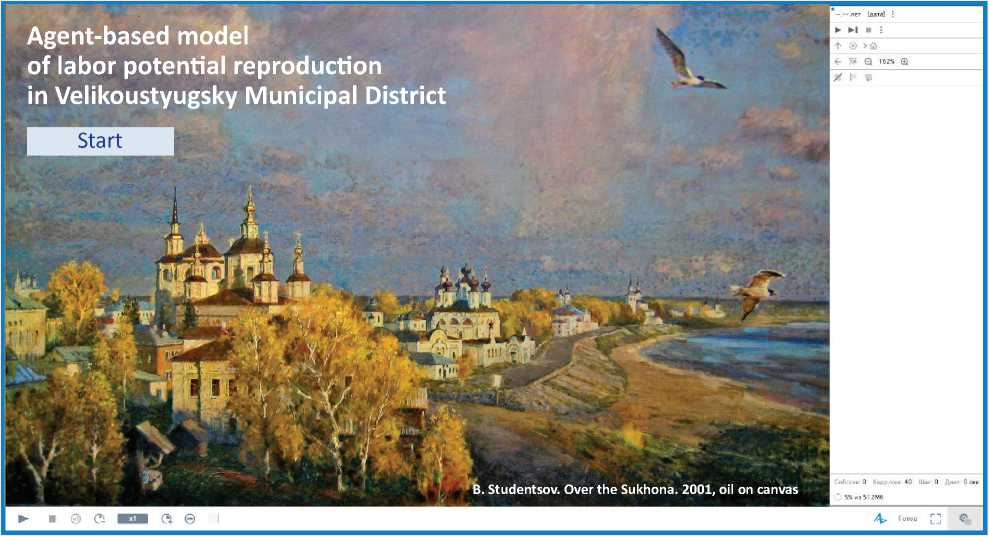
Figure 3. View area of the dynamics of the population structure and number
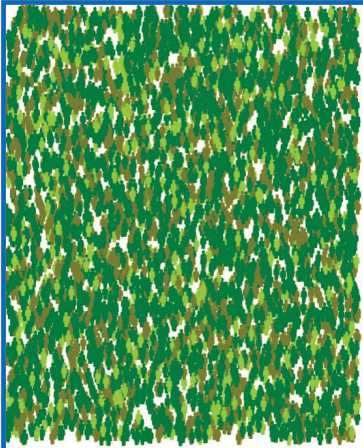
Physical health
Mental health
Cognitive Sociability Moral level potential
Creative Cultural potential level
Achievement need
Dynamics of the population structure and number
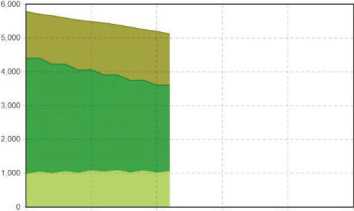
2011 2015 2020 2025 2030 2035
• Younger than working age • Of working age
• Older than working age
Q) people w Person [5087]
Qbfirms vFirm [13]

► ■ ® Cl El © ©
Figure 4. View area of the dynamics of population’s creative potential
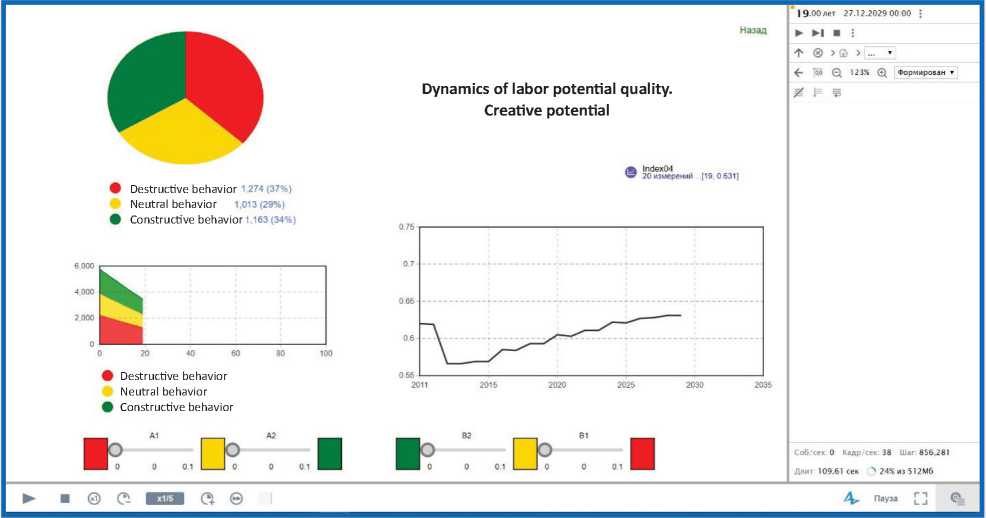
(B. Studentsov. Over the Sukhona. 2001, oil on canvas), which is the administrative center of the municipal district and where our developments were tested. This is a kind of “cover” of the model.
The view area of the age structure and population ( Fig. 3 ) allows a user and modeler to observe the dynamics of population decrease and aging. It reflects data on the current number of agents-people and provides an opportunity to view the dynamics of individual qualitative characteristics of labor potential at the links.
For example, Figure 4 shows a view area of the dynamics of creative potential. In this case the computational experiment results reflect the change in the index according to the inertial scenario with the stability of existing types of behavior, without transitions between them (coefficients A1, A2, B1 and B2, which determine transition probability and are controlled by “sliders”, are zero). As can be seen from the figure, the index failure, recorded at the beginning of the period, will be restored only to 2025. At the same time, if at least 1% of the working-age population with destructive and neutral behavior changes its attitude to creativity for the better (A1=A2=0.01), the index value will recover a year earlier and continue to grow gradually.
The analysis of quality of the model by means of retrospective forecast ( tab. 2 ) shows that the deviation of the modeling results from the official data on the total population in 2012–2018 (as of January 1), published in the statistical collections of Vologda Oblast, does not exceed 0.7%. At the same time, the working age population calculated on the basis of the modeling results – the main quantitative indicator of the accumulated labor potential in the region – deviates from the statistical data by no more than 2.4%. The obtained indicators show good quality of the model and its suitability for practical application in order to predict the dynamics of labor potential of
Table 2. Comparison of modeling results with official statistics, as of the beginning of the year (scale 1:10)
Naturally, the assumptions and suggestions made in the model, as well as the initial data used, impose certain limitations on its applicability. The model is a simplified reflection of reality. This should be understood and taken into account. The main drawback of a current version of the model, which can not yet be eliminated due to limitations of the available information base, is significant conventionality of the data on labor potential quality of the population younger than working age, since only persons of working age fall into the sample of the monitoring of the qualitative state of labor potential of the Vologda Oblast population, carried out by the VolRC RAS. Perhaps, in the future it will be possible to solve this problem. So far, data on the quality of labor potential of the older, “parent” generation are used to set the qualitative characteristics of “children” [13].
The main thing is that we have managed to create a workable tool for analysis and forecasting of labor potential reproduction, reflecting the dynamics of labor potential of a municipality in unity and the relationship of its quantitative and qualitative aspects and helping test management decisions in an artificial society to improve the efficiency and sufficiency of real processes management.
At the moment, theoretical significance of the model is to develop procedures for simulating labor potential reproduction on the basis of the concept of qualitative characteristics of the population and the paradigm of agentbased modeling. As for practical significance of the model, it provides opportunities for testing management actions and conducting computational experiments.
As is known, an agent-based model is a flexible tool that can adjust simulation procedures, adding new types of agents and interactions, changing agents’ characteristics when new information appears, etc., almost endlessly perfecting its developments. However, the priority direction for further development of our complex agent-based model of reproduction of labor potential of a municipality is to consider real needs of the practice and upgrade the model, so it can have practical application.
Список литературы Integrated agent-based model of labor potential reproduction of a municipal formation
- Chekmareva E.A. Research into the conditions and drivers of labor potential reproduction in the Vologda Oblast municipal districts. Ekonomicheskie i sotsial’nye peremeny: fakty, tendentsii, prognoz=Economic and Social Changes: Facts, Trends, Forecast, 2016, no. 5, vol. 47, pp. 173-194. DOI: 10.15838/esc.2016.5.47.10
- Gaffard J.-L., Napoletano M. Agent-Based Models and Economic Policy. Paris: OFCE, 2012. 448 p.
- Furtado B.A. Policy Space: Agent Based Modeling. Rio de Janeiro: Ipea, 2018. 121 p.
- Makarov V.L., Bakhtizin A.R. Sotsial’noe modelirovanie -novyi komp’yuternyi proryv (agent-orientirovannye modeli) . Мoscow: Ekonomika, 2013. 295 p.
- Makarov V.L., Bakhtizin A.R., Sushko E.D. Agent-based models as a means of testing of management solutions. Upravlencheskoe konsul’tirovanie=Administrative Consulting, 2016, no. 12, pp. 16-25..
- Chekmareva E.A. Agent-based models in municipal administration. Problemy razvitiya territorii=Problems of Territory’s Development, 2017, no. 6, vol. 92, pp. 121-135..
- Mendritzki S. Artificial Policy: Examining the Use of Agent-Based Modeling in Policy Contexts: M.S. Thesis. Alberta: University of Calgary, 2010. 130 p.
- Epstein J.M., Axtell R.L. Growing Artificial Societies: Social Science from the Bottom Up. Cambridge: MIT Press, 1996. 224 p.
- Epstein J.M. Generative Social Science: Studies in Agent-Based Computational Modeling. Princeton: Princeton University Press, 2006. 384 p.
- Helbing D. (Ed.) Social Self-Organization: Agent-Based Simulations and Experiments to Study Emergent Social Behavior. Springer; 2012. 341 p DOI: 10.1007/978-3-642-24004-1
- Sushko E.D. Labor potential and behavior of people in the multi-agent model of the region. Vestnik universiteta=Bulletin of the University, 2011, no. 3, pp. 183-186..
- Sushko E.D. Mul’tiagentnaya model’ regiona: kontseptsiya, konstruktsiya i realizatsiya: preprint # WP/2012/292 . Мoscow: TsEMI RAN, 2012. 54 p.
- Chekmareva E.A. A concept model of labor potential reproduction at the municipal level: an agent-based approach. Sotsial’noe prostranstvo=Social Area, 2017, no. 4, vol. 11. Available at: http://sa.vscc.ac.ru/article/2376.
- Becker G.S. Human Capital: Theoretical and Empirical Analysis with Special Reference to Education. 3rd ed. Chicago: University of Chicago Press, 1993. 412 p.
- Dawid H., Gemkow S., Harting P., Neugart M. Labor market integration policies and the convergence of regions: the role of skills and technology diffusion. Journal of Evolutionary Economics, 2012, vol. 22, iss. 3, pp. 543-562 DOI: 10.1007/s00191-011-0245-1
- Rimashevskaya N.M., Kopnina V.G. (Eds.). Kachestvo naseleniya . Мoscow: ISEPN RAN, 1993. 185 p.
- Pankratov A.S. Trudovoi potentsial: sotsial’no-ekonomicheskie aspekty upravleniya protsessom ego vosproizvodstva: dis. v vide nauch. dokl. na soisk. uch. st. d.e.n.: 08.00.05. . Мoscow, 1993. 60 p.
- Maslova I.S. Trudovoi potentsial sovetskogo obshchestva: voprosy teorii i metodologii issledovaniya . Мoscow, 1987. 32 p.
- Fagiolo G., Roventini A. On the Scientific Status of Economic Policy: A Tale of Alternative Paradigms. Laboratory of Economics and Managemente (LEMB), Sant’Anna School of Adv Studies, Pisa, Italy, LEM Working Paper Series, February 2008. 28 p.
- Ilyin V.A., Smirnova N.A., Timofeeva Ya.B. Kachestvo trudovogo potentsiala naseleniya Vologodskoi oblasti . Vologda: VNKTs TsEMI RAN, 1998. 72 p.
- Kalachikova O.N., Korchagina P.S. The main trends of self-preservation behavior of the region’s population. Problemy razvitiya territorii=Problems of Territory’s Development, 2012, no. 5, pp. 72-82..
- Leonidova G.V., Ustinova K.A. Lifelong learning as a condition for human capital formation. Ekonomicheskie i sotsial’nye peremeny: fakty, tendentsii, prognoz=Economic and Social Changes: Facts, Trends, Forecast, 2012, no. 6, pp. 124-137..
- Leonidova G.V., Vyacheslavov V.N. Gender Specifics of Intraregional Migration. Voprosy territorial’nogo razvitiya=Territorial Development Issues, 2016, no. 2. Available at: http://vtr.vscc.ac.ru/article/1822.
- Kalachikova O.N., Shabunova A.A. Reproduktivnoe povedenie kak faktor vosproizvodstva naseleniya: tendentsii i perspektivy: monografiya . Vologda: ISERT RAN, 2015. 172 p.
- Villamor G.B., van Noordwijk M., Troitzsch K.G., Vlek P.L.G. Human decision making for empirical agent-based models: construction and validation. In: Seppelt R., Voinov A.A., Lange S., Bankamp D. (Eds.). Managing Resources of a Limited Planet: proceedings of the sixth biannial meeting of the International Environmental Modelling and Software Society, Leipzig, Germany, July 1-5, 2012. Leipzig: International Environmental Modelling and Software Society, 2012, pp. 2529-2536.
- Borshchev A.V. How to build simple, beautiful and useful models of complex systems. In: Imitatsionnoe Modelirovanie. Teoriya i Praktika IMMOD 2013 . Kazan’: Fen AN RT, 2013, vol.1, pp. 21-34..
- Grimm V., Berger U., Bastiansen F., Eliassen S., Ginot V., Giske J., et al. A standard protocol for describing individual-based and agent-based models. Ecological Modelling, 2006, vol. 198, iss. 1-2, pp. 115-126 DOI: 10.1016/j.ecolmodel.2006.04.023
- Grow A., Van Bavel J. (Eds.) Agent-Based Modelling in Population Studies: Concepts, Methods, and Applications. Cham: Springer, 2017. 513 p DOI: 10.1007/978-3-319-32283-4
- Hamill L., Gilbert N. Agent-Based Modelling in Economics. Chichester: WILEY, 2016. 246 p DOI: 10.1002/9781118945520

